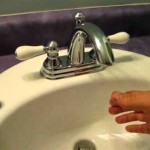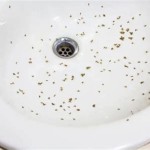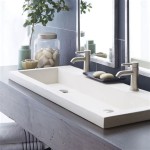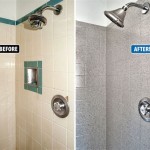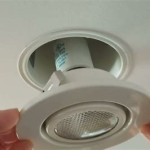Best Bathroom Faucet for Rectangular Sink: A Comprehensive Guide
Selecting the right bathroom faucet for a rectangular sink involves careful consideration of several factors. The faucet must complement the sink's design, provide adequate water flow, and be durable enough to withstand daily use. This article explores the key aspects to consider when choosing a bathroom faucet, highlighting different faucet types and their suitability for rectangular sinks.
Understanding Rectangular Sink Dimensions and Faucet Placement
Rectangular sinks offer a modern aesthetic and increased surface area compared to traditional round or oval sinks. However, their unique shape requires careful attention to faucet placement. The dimensions of the sink, including its width, depth, and the distance from the faucet holes to the edge of the sink, are crucial measurements. These dimensions will influence the reach and height of the faucet spout needed to effectively deliver water into the basin without splashing.
The faucet’s reach, which is the horizontal distance from the base of the faucet to the point where the water stream exits, is particularly important. A spout that is too short might cause the water to hit the back of the sink, leading to splashing. Conversely, a spout that is too long might extend too far into the sink, making it uncomfortable to use. The height of the faucet, defined as the vertical distance from the base to the spout, is another critical factor. A taller faucet allows for more clearance underneath the spout, which can be beneficial for washing hands or filling containers.
Faucet placement options also affect the selection. For sinks with pre-drilled holes, the faucet must match the hole configuration (single-hole, centerset, or widespread). If the sink is designed for a wall-mounted faucet, the placement will be dictated by the wall studs and plumbing access behind the wall.
Faucet Types and Their Advantages for Rectangular Sinks
Various faucet types are available, each with its own design characteristics and suitability for rectangular sinks. The primary faucet types include single-hole faucets, centerset faucets, widespread faucets, vessel faucets, and wall-mounted faucets.
Single-hole faucets are designed for sinks with a single pre-drilled hole. They often feature a sleek, minimalist design and are easy to install. Single-hole faucets are available in various styles, including those with a lever handle or a two-handle configuration built into the faucet body. These faucets are suitable for rectangular sinks that prioritize a clean and modern look.
Centerset faucets are designed for sinks with three holes spaced 4 inches apart. The handles and spout are typically mounted on a single base, providing a compact and unified appearance. Centerset faucets are a versatile option for rectangular sinks, offering a balance of style and functionality. Their compact design makes them well-suited for smaller rectangular sinks where space is limited.
Widespread faucets are designed for sinks with three holes spaced 8 inches or more apart. The handles and spout are separate components, allowing for a more customized and elegant look. Widespread faucets are often chosen for larger rectangular sinks, as they can visually fill the space and create a more luxurious aesthetic. They allow for greater flexibility in handle placement, enabling designers to create a unique and personalized bathroom layout.
Vessel faucets are designed for use with vessel sinks, which sit on top of the countertop rather than being recessed. These faucets are typically taller than standard faucets to provide adequate clearance above the sink. Vessel faucets are available in various styles, including single-handle and two-handle options, and can be either deck-mounted or wall-mounted. When selecting a vessel faucet for a rectangular vessel sink, it is important to consider the sink's height and width to ensure proper water flow and prevent splashing.
Wall-mounted faucets are installed on the wall behind the sink, rather than on the countertop. They offer a clean and minimalist look, as they eliminate the need for holes in the countertop. Wall-mounted faucets are particularly well-suited for rectangular sinks, as they can complement the sink's clean lines and geometric shape. However, installation of a wall-mounted faucet requires careful planning and plumbing access behind the wall.
Material and Finish Considerations for Faucet Durability and Aesthetics
The material and finish of a bathroom faucet significantly impact its durability, performance, and visual appeal. Common faucet materials include brass, stainless steel, and zinc alloy. Each material offers different levels of resistance to corrosion, wear, and tear. The finish, such as chrome, brushed nickel, oil-rubbed bronze, or matte black, affects the faucet's aesthetic and its ability to resist tarnishing and water spots.
Brass is a popular choice for bathroom faucets due to its durability and resistance to corrosion. Brass faucets are often plated with a finish such as chrome or brushed nickel to enhance their aesthetic appeal and protect the underlying material. Brass faucets are generally more expensive than those made from other materials, but their longevity and performance make them a worthwhile investment.
Stainless steel is another durable and corrosion-resistant material commonly used for bathroom faucets. Stainless steel faucets offer a clean and modern look and are easy to maintain. They are also resistant to fingerprints and water spots, making them a practical choice for high-use bathrooms. Stainless steel faucets are typically more affordable than brass faucets, but they may not offer the same level of durability.
Zinc alloy is a more affordable material option for bathroom faucets. While zinc alloy faucets can be visually appealing, they are generally less durable and more prone to corrosion than brass or stainless steel faucets. Zinc alloy faucets are often coated with a finish to improve their appearance and protect the underlying material, but the finish may wear off over time.
The faucet finish plays a crucial role in determining the faucet's overall aesthetic and its ability to withstand daily use. Chrome is a classic and versatile finish that offers a bright and reflective surface. Chrome finishes are relatively easy to clean and are resistant to tarnishing, but they can show fingerprints and water spots. Brushed nickel is a popular alternative to chrome, offering a softer and more matte appearance. Brushed nickel finishes are less likely to show fingerprints and water spots than chrome, making them a practical choice for busy bathrooms. Oil-rubbed bronze is a rich and warm finish that adds a touch of elegance to any bathroom. Oil-rubbed bronze finishes are often distressed to create a rustic and antique look. They are also resistant to tarnishing and corrosion. Matte black is a modern and stylish finish that has gained popularity in recent years. Matte black finishes offer a bold and dramatic look and are resistant to fingerprints and water spots. However, matte black finishes may be more prone to scratching than other finishes.
Water Flow Rate and Water Conservation
The water flow rate of a bathroom faucet, measured in gallons per minute (GPM), is an important consideration for both functionality and water conservation. Federal regulations mandate that bathroom faucets have a maximum flow rate of 2.2 GPM. However, many faucets are designed to meet WaterSense standards, which require a maximum flow rate of 1.5 GPM. Choosing a WaterSense-certified faucet can significantly reduce water consumption without sacrificing performance.
A lower flow rate faucet can save water and reduce water bills, but it may also provide a less powerful water stream. When selecting a faucet for a rectangular sink, it is important to consider the desired water pressure and volume. If a strong water stream is preferred, a faucet with a higher flow rate may be necessary. However, if water conservation is a primary concern, a WaterSense-certified faucet with a lower flow rate is a more sustainable choice.
Some faucets feature adjustable flow rate settings, allowing users to customize the water pressure and volume to their preferences. These faucets can be particularly useful for rectangular sinks, as they allow users to fine-tune the water flow to minimize splashing. Additionally, aerators, which are small devices that screw onto the end of the faucet spout, can be used to reduce water consumption without sacrificing water pressure. Aerators mix air with water, creating a wider and more consistent water stream that feels more powerful than it actually is.
Installation and Maintenance
Proper installation is essential for ensuring the long-term performance and reliability of a bathroom faucet. While some homeowners may choose to install the faucet themselves, professional installation is generally recommended, particularly for complex installations such as wall-mounted faucets. Professional plumbers have the expertise and tools necessary to ensure that the faucet is properly installed and that all connections are secure.
Regular maintenance is also important for keeping a bathroom faucet in good working condition. This includes cleaning the faucet regularly to remove mineral deposits and water spots, checking for leaks and repairing them promptly, and lubricating moving parts as needed. Hard water can cause mineral deposits to accumulate on the faucet, which can reduce water flow and damage the finish. Using a mild cleaner and a soft cloth to clean the faucet regularly can help prevent mineral buildup. Avoid using abrasive cleaners or scouring pads, as these can scratch the finish.
Checking for leaks is another important maintenance task. Leaks can waste water and damage surrounding surfaces. If a leak is detected, the faucet should be repaired promptly. Common causes of faucet leaks include worn-out O-rings, loose connections, and damaged cartridges. Replacing worn-out parts or tightening loose connections can often resolve minor leaks. For more complex repairs, it may be necessary to consult a professional plumber.
Lubricating moving parts, such as handles and spouts, can help prevent them from becoming stiff or difficult to operate. Use a silicone-based lubricant specifically designed for plumbing fixtures. Avoid using petroleum-based lubricants, as these can damage rubber parts.
Bathroom Faucets Kingston Brass

Find The Best Bathroom Faucets For Your Home Jaquar

Bathroom Faucet Black Waterfall Rectangular Single Hole Ceramic Cartridge Hot Cold Adjustable Square Mixer Tap For Basin Stainless Steel Matt

The 7 Best Bathroom Faucets Of 2024 Vigo Blog Kitchen And Shower Ideas

Waterfall Bathroom Faucet Basin Mixer Tap Stainless Steel Rectangular Flat Spout Cold Hot Water Available Modern Chrome Style Yao Ca

Vigo Matte Stone Jasmine Composite Rectangular Vessel Bathroom Sink In White With Niko Faucet And Pop Up Drain Chrome Vgt1262 The Home Depot Best Faucets Amazing Bathrooms

51 Bathroom Faucets To Complete Your Dream Sink Update

Zalerock Rectangular Waterfall Single Handle Wall Mounted Bathroom Faucet In Gold H02ltbg034 The Home Depot

The Best Bathroom Sinks Faucets On A Budget Kylie M Interiors

Bathroom Sink Faucet With Led Light Waterfall Spout Brass Black Lacquer Side Opening
Related Posts
